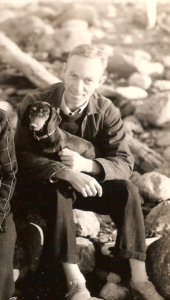
After reading the first few lines of “The Door” by E. B. White [1. found in Fifty Great Short Stories, Milton Crane (Ed.)] my immediate feeling was one of outrage: here I am reading a story by the author of a book that has generations of writers in terror of writing something the ‘wrong’ way (The Elements of Style by Strunk & White), and it’s all over the place! White is breaking his own rules with flagrant , jaw-dropping abandon!
Everything (he kept saying) is something it isn’t. And everybody is somewhere else. Maybe it was the city, being in the city, that made him feel how queer everything was and that it was something else. Maybe (he kept thinking) it was the names of things. The names were tex and frequently koid. Or they were flex and oid, or they were duroid (sani) or flexan (duro), but everything was glass (but not quite glass) and the thing that you touched (the surface, washable, crease-resistant) was rubber, only it wasn’t quite rubber and you didn’t quite touch it but almost.
OK, so there aren’t actually many disregarded rules there, apart from possibly some missing quotation marks – but still! What an odd and unbalancing opening that is.
And I loved it. Because the words are doing exactly what the writer intends to convey: they are confusing and disjointed and all out of kilter. They are slightly beyond comprehension. Just likethat we are in the same emotional space as the main character.
You couldn’t do this without a good command of the norms of writing, so perhaps E. B. White is exactly the right person to be writing this story!
Why The Story Works
This was a trying story on a first reading. I was never really sure what was going on, although I have my own ideas. It was like reading a stream-of-consciousness Beat poem.
But it hung together. It worked even though little in the story is explicit.
Some reasons it worked:
- It was visceral. The writer takes us right inside the head of someone who is disorientated and out of step with the world. He keeps us off-kilter with his language. We are never explicitly told what is up with the main character (they way we may not know what’s up with ourselves when we are ‘out of sorts’). We do, however, feel what the character is feeling, through this helter-skelter narrative.
- We are inside his head, though it is not all first-person. The story switches point of view without fanfare, so sometimes we are in first person and sometimes not (“Maybe (he kept thinking) it was the name of things”).
- The author sets up a metaphor at the beginning, that of rats in a scientific experiment, “…trained to jump at a square card with the circle in the middle of it…”. It is a clear and coherent part of the story. He then takes this metaphor and alludes to it throughout the story, using the phrase ‘the one with the circle on it’ in various places to let us know he’s talking about frustrated expectations or unexpected changes — about life changing the rules, just when we’ve got the hang of them — whether or not we know what’s going on in the particular moment (and on a second reading, these moments become more clear).
- The story (and the protagonist) travel somewhere. At the end, I’m still not exactly sure what is going on, but I know more than I did at the beginning. The protagonist is moving on.
- The ending has a finality to it, a sense of actually being an ending. The author ties everything up in a bow by bringing back some metaphors from earlier in the story, the way a modern stand up comics will bring us back around to a joke from the start of their routine, before taking their bow.
This was an oddly satisfying story.
I think it is made more difficult by reading it at a time (and as part of a culture) very different from the the one in which it was written. Life was changing for the protagonist in ways that reflected the times. Now, 70+ years later, it’s hard to catch all the cultural allusions (without studying more deeply).
The style feels very modern (or possibly “Modern”) in its form and ambition. In fact, I was stunned to find it was originally published in 1939. I think it would still prove a bit too avant garde for many readers.
But it was anything but boring.
Writer’s Tips
If you are uninspired by a story that you are writing, maybe it’s because you are sticking too closely to the rules, to a formula.
Try taking a leaf out of E. B. White’s book and mess with your readers a bit.
- Try a different style.
- Say less — or more.
- Drop the dialogue attributions.
- Throw out the quotation marks.
- Write run-on sentences — or write in fragments.
- Tell the story out of order.
- Try to make your language sound less like you and more like the inside of your character’s head. Let the words race, if your character is running; or make them lugubrious if she is weary.
- Allow yourself to take some chances.
After all, words are just squiggles on a page, and even the most experimental squiggles can be erased and re-written.
Take some chances in your writing today.
Did you try any new techniques after reading this? Leave a comment (and a link, if you’re daring) and let us know what worked – or didn’t.

![[Tuesday Reading Room] The Door by E. B. White](https://storyaday.org/wp-content/uploads/2012/03/EB_White_cropped.png)